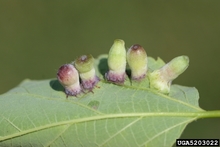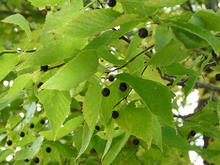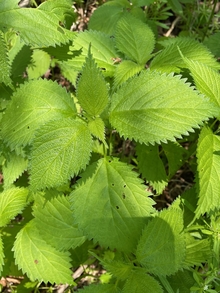Have you seen our lists of recommended native plants and trees for your backyard woods in East Central Minnesota? One of the things that we’ve found so rewarding about this project is learning about the interactions of some of the trees, understory plants, and wildlife you might find in your nearest woodland. Here are a few species worth a closer look.
Common hackberry (Celtis occidentalis)
I’ve long been an admirer of hackberry, a tree that historically grew in much of Minnesota except for the Arrowhead. This tree was in the same family as elm (Ulmaceae) but new DNA information prompted a move to the Cannabaceae family, which includes hemp and hops plants. Hackberries have interesting, corky bark that makes identification fairly easy. Hackberry has light brown ring-porous wood, which looks similar to ash. The wood is used for furniture, boxes and veneers.
Our rewilding project specifically focuses on plants that are good for the little critters we call ecosystem ambassadors. As a result, it’s important to note that a common insect found on the leaves of hackberry, which are so common as to be a useful species identifier, is a tiny planthopper-like bug aptly named hackberry nipple gall maker (Pachysylle spp.).
This small bug doesn’t hurt the leaves but it is very common, distinct and noticeable. The hackberry nipple gall maker is eaten by native fox squirrels which also eat the berries. Hackberry fruit is enjoyed by many birds including northern bobwhite quail, wild turkey, cedar waxwings, sharp-tailed grouse, yellow-bellied sapsuckers and robins. The fruit persists on the trees through the winter making it a very valuable, nutritious staple for overwinter and migratory birds.
Hackberries are important for pollinators because they bloom very early in mid-April, and they are especially important for specialist species like the hackberry butterfly (Asterocampa celtis). Hackberries are an adult food source for the uncommon wild cherry sphinx moth (Sphinx drupiferarum), and are larval hosts for butterfly species tawny emperor (Asterocampa clyton), question mark (Polygonia interrogationis), and showy mourning cloak (Nymphalis antiopa).
However, what I find most interesting about hackberries is how long plants in this genus have been important for humans. Fruit remnants have been found in archeological sites in Turkey, Peru, Sudan, and Indonesia. It was even found in China at the same site as the “Peking Man” who is estimated to be 500,000 years old!
The fruit is hard to reach in large mature trees, but doesn’t go bad because of its high sugar and low moisture content, similar to dates. The small berries can be harvested and eaten raw, or soaked and cooked throughout the winter. The fruit has a large hard seed more akin to a nut than a soft-sided berry, and the fruit is rich in both oil and protein, making it surprisingly filling and nutritious. Communities indigenous to North America used common hackberry berries as food, flavor for meat, and fuel for altar fires. The bark has also been used as a medicine. I enjoy eating the fleshy fruit raw as I hike in the winter — they remind me of crunchy raisins, a delicious treat waiting on the snow.
Wood nettle (Laportea canadensis)
Wood nettle can be found throughout Minnesota, but is easily confused with stinging nettle (Urtica dioica) and false nettle (Boehmeria cylindrica). Wood nettle has alternate leaf arrangement, whereas stinging and false nettle both have opposite leaf arrangements. Nettles, including wood nettle, are often known for their irritating stings which occur when the leaves brush against bare skin. The pain is severe and short lived, but there are two common native plants in the jewelweed family that often grow near nettles and can be used to soothe stings. People can quickly and easily relieve nettle stings by rubbing the area with the crushed stems of spotted touch-me-not (Impatiens capensis) and pale touch-me-not (Impatiens pallida).
While you may not want wood nettle growing near your nature-based play area, it is a valuable larval host for the red admiral butterfly (Vanessa atalanta). Indigenous communities used wood nettle for many medicinal purposes and for twine and basket making. Even more interesting, wood nettle is commonly foraged for use as a green leafy vegetable or for soups. The young plants are enjoyed most and must be cooked to take the sting away. For more information about wood nettle as food visit this NC State Extension’s website.
Question mark butterfly (Polygonia interrogationis)
There are so many little critters that make Minnesota’s ecosystems interesting. The question mark butterfly is a small but conspicuous orange and brown butterfly commonly found on wooded edges and in parks. When the butterfly’s wings are folded, the brown underside mimics the color and shape of a dead leaf, creating important camouflage. This species’ name comes from a small, silver, question mark-shaped marking on the underside of the hindwing.
The question mark butterfly caterpillar reminds me of a wild undersea creature, with branched cuticles that resemble compound spikes. It can use many plants including both wood nettle and hackberry. The adults feed on rotting fruit, tree sap, dung and carrion (dead animals).
Though much less common than the question mark butterfly, the wild cherry sphinx moth (Sphinx drupiferarum) also depends on hackberry and other native host plants, such as its namesake wild cherry plum. Like most moths the adults are nocturnal, however they can travel up to 60 miles a night, a remarkable distance for such a small creature! The caterpillars have several stages and are mostly green with a noticeable dark pink caudal horn, which resembles a pointed tail. The largest caterpillar stage also has pink stripes along the pale green sides.





